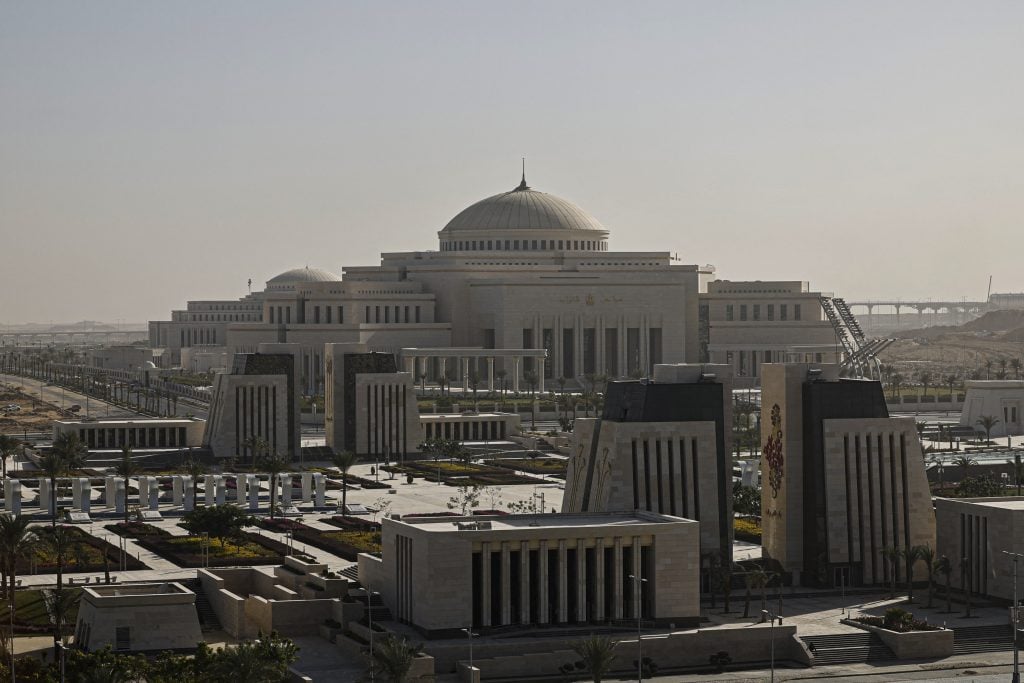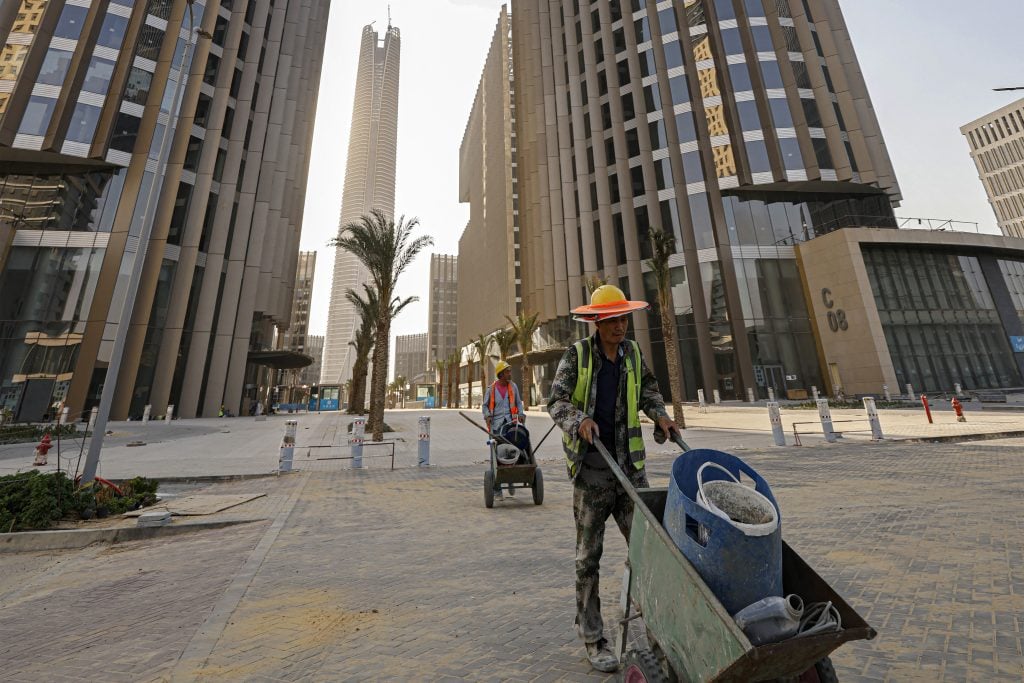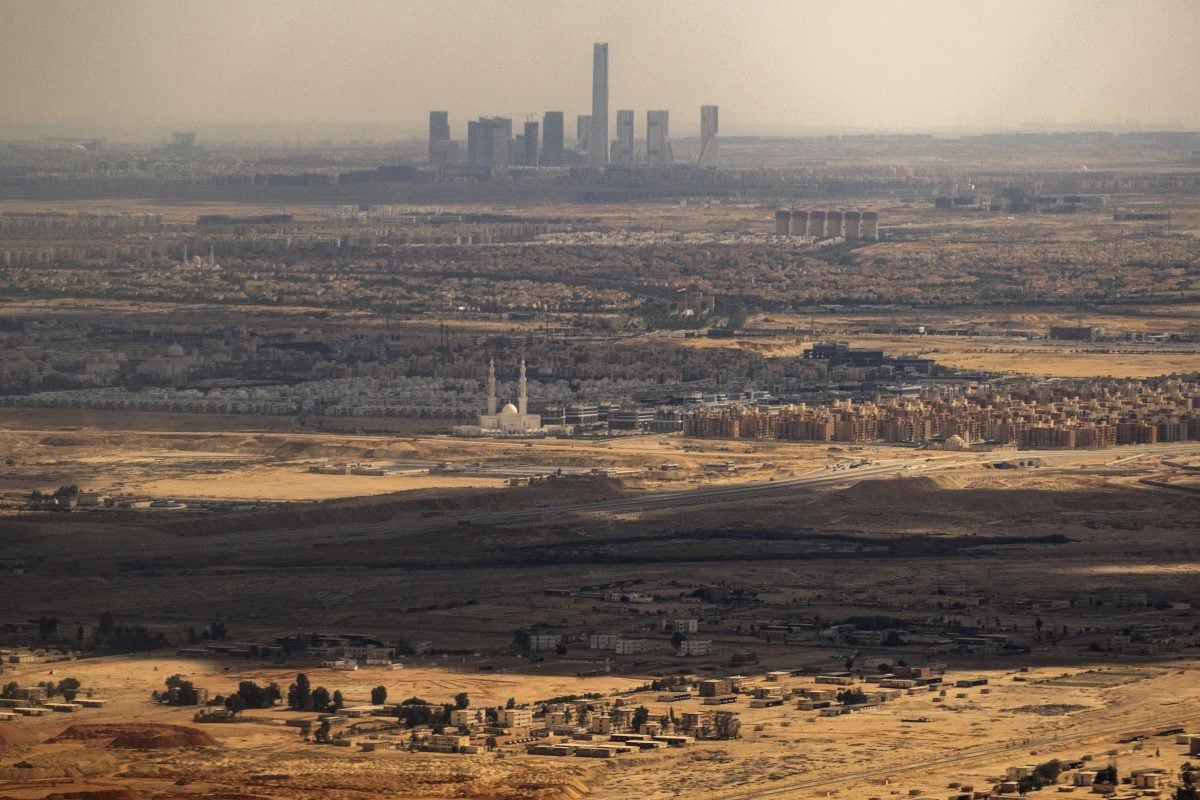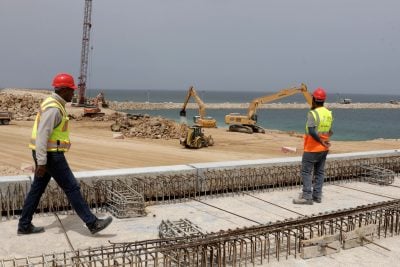Egypt’s New Administrative Capital (NAC), a project that started 10 years ago with the signing of a technical plan, is inching towards completion.
Just over an hour’s drive separates Cairo from the new development, a span of time that takes visitors from the ancient city to an ensemble of soaring buildings in the desert. Here are located government ministries and offices, the parliament and senate buildings, a growing number of companies, and around 1,500 families who have moved into the limited number of mostly high-end residential properties that have been completed so far.
The project, owned and operated by the government’s Administrative Capital for Urban Development (ACUD), is estimated to cost a total of $58bn. The city, which is being built in phases, has a total potential area of 950 km² and an 8,000,000 population capacity.
Attractions such as the Museum of Egyptian Capitals and the National Library in the New Administrative Capital, as well as a “diplomatic quarter” for the embassies of “friendly countries around the world” are expected to place the city at the heart of modern Egypt’s cultural and diplomatic life.
Religion too, has its place – the city includes the Misr Islamic Center – one of the largest mosques in the world – and the Cathedral of Nativity of Christ, a sprawling Coptic Orthodox church.
The broader objectives of the NAC, a spokesman tells African Business, include alleviating congestion in Greater Cairo, with its population of 22.9m; stimulating economic development and investment; and promoting sustainable urban growth. The project is also intended to be a driver of Egypt’s digital transformation and regional standing.
The project is accompanied by other mega-projects with the same goal under the Egypt Vision 2030 framework. That includes the planned construction of cities like New Alamein, New Mansoura, Ras El-Hekma City and Galala City. The fate of NAC, the most ambitious project of its kind and a potential model for the others, is thus being closely watched.
But while the government promises a modern, green metropolis well suited to the needs of residents and visitors alike, some environmental and social campaigners doubt that the project offers a sustainable solution to a 118m-strong country struggling to cope with severe climate and economic pressures.

A tough backdrop
While the ambitious project has continued apace over the last decade, Egypt has experienced mixed economic fortunes. The impacts of Covid-19, the Russia-Ukraine war and the travils of a largely unreformed state-dominated economy have weighed on growth, which peaked at 6.7% in the pandemic bounce-back year of 2022, but is projected by the IMF at 3.8% this year.
Meanwhile, the cost of basic goods has consistently increased, with annual inflation reaching a peak in June 2023 of around 41%. Around 35m Egyptians now live under the poverty line, says lawyer Malek Adly at the Egyptian Center for Economic and Social Rights.
Many low-income families live in informal settlements and urban suburbs that lack proper infrastructure and water and electricity systems. Around 40% of urban areas and 95% of rural areas in Egypt are considered unplanned: 60% of people in the Greater Cairo region live in informal settlements. Meanwhile, 96% of the total population lives in 6% of the total national area, leading to overcrowding and unplanned urban sprawl.
Critics doubt whether the NAC can help alleviate the burdens that poorer Egyptians face in degraded areas of Cairo and other major cities which are in need of transformative investment. More than 70% of Egyptian cities are considered of low development potential, according to a national urban policy diagnostic study cited by UN-Habitat.
“Availability of affordable, adequate, and accessible housing is a challenge that leaves many low-income Egyptians living in informal areas with poor standards of living, often lacking access to main public services and transportation,” the organisation says.
Planners say that a total of eight residential districts are planned for the NAC. They say that each district of the city will contain “commercial and administrative areas, gardens, schools, police stations, post offices, gas stations, etc., and other necessary services for the NAC residents.”
But Adly says the project does not include adequate housing provision for those from lower income groups.
“While any new projects increasing residential land slightly relieve the congestion, these will barely help if they do not provide social housing for low-income families, and to our knowledge at this stage, they do not include such [housing],” he says.
Based on African Business research on property search platforms, the cheapest residential property starts from around EGP 2m (around $40,000), well beyond the reach of many low-income Egyptians. Adly says the project risks boosting the real estate and construction sectors while leaving other urban challenges unmet.
“Social sustainability depends on three elements: a place that is offered to people from diverse economic and social backgrounds; a place that provides services and workplaces; and a place that represents a smart solution taking into consideration the economic circumstances we are in. Can you imagine if ten years ago, instead of investing in construction and real estate, we had invested in education, health, research, industry or technology?” he asks.
Environmental credentials questioned
The NAC is just one of several ambitious “new city” projects taking shape across Africa. Nigeria’s Eko Atlantic City, Kenya’s Konza Technopolis and Angola’s Kilamba New City are other ambitious urban spaces under construction.
A major claim of planners is that new cities can effectively start from scratch with modern, sustainable infrastructure that would be logistically harder and much more expensive to incorporate into existing urban environments.
The New Urban Communities Authority (NUCA), a government agency responsible for satellite cities, says the NAC will use solar power for street lighting and public buildings and include smart water irrigation systems. It plans to install solar panels and batteries on 50% of rooftops and establish recycling stations. It also says the city will have the largest district cooling plant in Africa, which it says will help make the city “one of the most energy-efficient in the region”. The city’s transport master plan includes buses that run on natural gas.
But Ecoris, an Egyptian association that promotes awareness of the environment and sustainable development, says sustainability at the NAC will have to go beyond these well-promoted initiatives.
“Sustainability is an integrated model of planning and equitable use of resources. In the case of the NAC, there is indeed an effort to create ‘green’ urban features, but when we put this in the context of the project as a whole, we find that the impact is very limited and may even be cosmetic,” Asmaa Aly, founder and CEO of Ecoris, tells African Business.
Egypt is particularly vulnerable to climate threats given its densely concentrated population in the Nile Valley, where 90% of the country’s residents live. In recent years the river’s flow has decreased due to rising temperatures and evaporation, endangering water resources. Egypt also claims that the filling of Ethiopia’s Grand Renaissance Dam from the waters of the Blue Nile risks depriving it of crucial water.
In 2021, UNICEF stated that formulating an urban development strategy which centres a just and efficient management of water resources is a time-sensitive necessity for Egypt, which at the time experienced an annual water deficit of 7bn cubic metres.
Aly says planned green spaces – 60% of the initial phase is dedicated to green services and spaces – could be “a major drain on water, especially in the absence of transparency about the sources of water used”.
“Environmentally, expanding into the desert will require an entirely new infrastructure – roads, water, electricity – and will increase rather than decrease the carbon footprint,” Aly claims.

Disconnect with population
Such concerns led Alternative Policy Solutions – a public policy research project at the American University in Cairo – to carry out a detailed background report on Egypt’s new urban projects, including the NAC.
In the report, author Nihal Salama says that “the high levels of housing vacancy, staggering real estate prices in the new urban communities, and the absence of public participation in urban planning call the sustainability of new mega-cities into question.”
She argues that the Egyptian urban development strategy would benefit from “espousing a more holistic understanding of sustainability to better tackle urban sprawl”.
“The current focus on smart city initiatives exhibits an overemphasis on economic growth and technocratic solutions, which often overshadows essential aspects of sustainability, such as social inclusivity and environmental stewardship. The disconnect between the real needs of the population and the priorities of these large-scale projects is glaring, particularly when considering that housing in these new cities is unaffordable for the majority of Egyptians.”
But proponents point to the potential boost to investment from such projects. China is particularly keen on the project – the $3.8bn central business district will be 85% funded by Chinese banks, with main contractor China State Construction Engineering Corporation also assuming responsibility for property management, operation, and maintenance and providing urban services to residents, tourists, and businesses. Egyptian state construction firm Arab Contractors is also involved.
The unspoken hope is that the city will replicate the economic and cultural sway of major urban centres in the Gulf such as Dubai and Abu Dhabi. But Salama says that a model that prioritises external investment can leave communities with little say.
“The dependence on external funding limits Egypt’s autonomy and may hinder the development of context-specific and locally driven sustainable urban initiatives. The government’s efforts to attract private sector investment in sustainable urban development projects are often driven by profit motives, rather than a genuine commitment to environmental and social sustainability,” she writes.
Instead, she argues that the city’s potential to bring about innovation and growth will be harnessed only if planners combat the wider social and climate-related concerns that the country’s existing urban areas face.
Salami says that Egypt’s New Administrative Capital and other smart city projects, “despite their green rhetoric, have so far failed to adequately address the socioeconomic disparities that plague Egypt’s urban landscape, [which] reinforces the need for a shift in focus toward a more holistic model of urban development, one that balances economic, social, and environmental sustainability”.
Want to continue reading? Subscribe today.
You've read all your free articles for this month! Subscribe now to enjoy full access to our content.
Digital Monthly
£8.00 / month
Receive full unlimited access to our articles, opinions, podcasts and more.
Digital Yearly
£70.00 / year
Our best value offer - save £26 and gain access to all of our digital content for an entire year!
 Sign in with Google
Sign in with Google 



